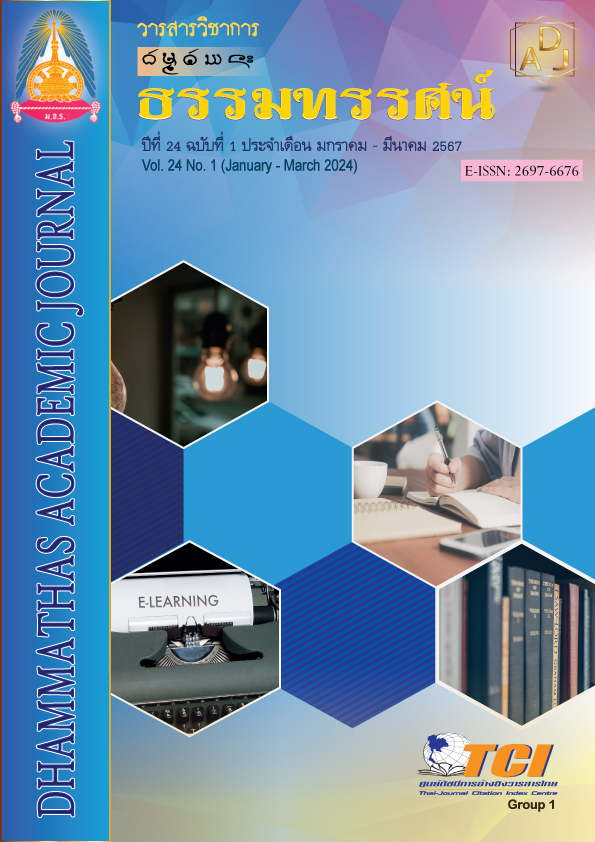An Analysis Four Elements of Empedocles and Theravada Buddhist Philosophy
Main Article Content
Abstract
The purposes of this research were; 1) to study the quaternary elements of Empedocles, 2) to study the Four Elements of Theravada Buddhist Philosophy, 3) to analyze the Four Elements of Empedocles and Theravada Buddhist Philosophy. It is a documentary research. Study data from primary and secondary documents, and also, analyze based on descriptive data in accordance with the inductive principle.
The results are shown as follows:
1. Empedocles' philosophy regarding the first elements It is the first element of all things or the universe. Aiming to explain the four elements, Empedocles had a combination of ideas between the philosophy of Heraclitus and the Aelia School until a new philosophy emerged that all things are both changeable and permanent. The first elements of the world consist of the form of matter combined with the elements of earth, water, air, fire or the four elements.
2. Theravada Buddhist philosophy has arranged the 4 elements in various states of living and non-living things, for example, the earth element is bones etc. The water element is blood, etc. The air element is wind, and the fire element is the warmth of the body and in non-living things such as the earth element, namely Iron, stone etc. The water element includes Drinking water, rivers, etc. The wind element includes wind blowing, etc. The fire element includes fire burning charcoal, etc. The 4 elements follow the laws of nature: they arise, remain, and disappear.
3. In the philosophy of Empedocles, the four elements were united by the power of love and separated by the power of hate. It is a durable substance. When separated, they return to their original elements. In Theravada Buddhist philosophy, the 4 elements are not combined, impermanent, suffering, non-self. The characteristics of the elements are similar. They differ from the philosophy of Empedocles. It was seen that the elements combined and separated were permanent. Theravada Buddhist philosophy there is no combination. According to the rules of the Trinity.
Article Details

This work is licensed under a Creative Commons Attribution-NonCommercial-NoDerivatives 4.0 International License.
เพื่อให้เป็นไปตามกฎหมายลิขสิทธิ์ ผู้นิพนธ์ทุกท่านต้องลงลายมือชื่อในแบบฟอร์มใบมอบลิขสิทธิ์บทความ ให้แก่วารสารฯ พร้อมกับบทความต้นฉบับที่ได้แก้ไขครั้งสุดท้าย นอกจากนี้ ผู้นิพนธ์ทุกท่านต้องยืนยันว่าบทความ ต้นฉบับที่ส่งมาตีพิมพ์นั้น ได้ส่งมาตีพิมพ์เฉพาะในวารสาร วิชาการธรรม ทรรศน์ เพียงแห่งเดียวเท่านั้น หากมีการใช้ ภาพหรือตารางของผู้นิพนธ์อื่นที่ปรากฏในสิ่งตีพิมพ์อื่นมาแล้ว ผู้นิพนธ์ต้องขออนุญาตเจ้าของลิขสิทธิ์ก่อน พร้อมทั้ง แสดงหนังสือที่ได้รับการยินยอมต่อบรรณาธิการ ก่อนที่บทความจะได้รับการตีพิมพ์References
จักรพรรณ วงศ์พรพวัณ. (2553). ปรัชญา: ศาสตร์แห่งภูมิปัญญามนุษย์. กรุงเทพฯ: ควอลิตี้ปริ้น.
จำนงค์ ทองประเสริฐ. (2518). ปรัชญาตะวันตกสมัยโบราณ. กรุงเทพฯ: แพร่พิทยา.
พระครูศรีโพธานุรักษ์ (ณัฐวุฒิ โสภาบุตร). (2553). การศึกษาเรื่องไฟในทัศนะพระพุทธศาสนาเถรวาท. (วิทยานิพนธ์พุทธศาสตรมหาบัณฑิต). พระนครศรีอยุธยา: มหาวิทยาลัยมหาจุฬาลงกรณราชวิทยาลัย.
พระธรรมโกศาจารย์ (ประยูร ธมฺมจิตฺโต). (2550). ปรัชญากรีก บ่อเกิดภูมิปัญญาตะวันตก. (พิมพ์ครั้งที่ 6). กรุงเทพฯ: ศยาม.
พระมหาบุญเลิศ วฑฺฒโน (กำเนิดทรัพย์). (2553). การศึกษาจตุธาตุวัฏฐานในพระพุทธศาสนาเถรวาท. (วิทยานิพนธ์พุทธศาสตรมหาบัณฑิต). พระนครศรีอยุธยา: มหาวิทยาลัยมหาจุฬาลงกรณราชวิทยาลัย.
พระเมธีธรรมาภรณ์ (ประยูร ธมฺมจิตฺโต). (2532). ปรัชญากรีกโบราณ. กรุงเทพฯ: อมรินท์พริ้นติ้ง.
มหาจุฬาลงกรณราชวิทยาลัย. (2539). พระไตรปิฎกฉบับมหาจุฬาลงกรณราชวิทยาลัย. กรุงเทพฯ: มหาจุฬาลงกรณราชวิทยาลัย.
สานุ มหัทธนาดุล. (2556). พัฒนาการแนวคิดเรื่องปฐมธาตุของโลกและชีวิต: เหตุผลที่พุทธศาสนาปฏิเสธ. (วิทยานิพนธ์พุทธศาสตรมหาบัณฑิต). พระนครศรีอยุธยา: มหาวิทยาลัยมหาจุฬาลงกรณราชวิทยาลัย.
สุวัฒน์ จันทรจำนง. (2540). ปรัชญาและศาสนา. กรุงเทพฯ: สุขภาพใจ.
Leonard, W. E. (1908). The Fragments of Empedocles. Chicago: The open court publishing company.
Samuel, E. S. (1982). Socrates to Sartre A History of Philosophy. New York: MC Graw-Hill.

